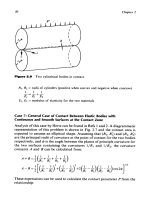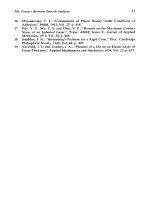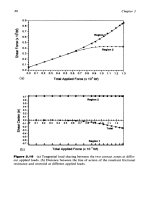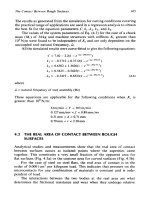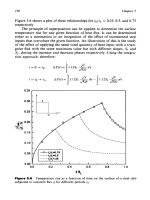Friction and Lubrication in Mechanical Design Episode 1 Part 7 pdf
Bạn đang xem bản rút gọn của tài liệu. Xem và tải ngay bản đầy đủ của tài liệu tại đây (1.02 MB, 25 trang )
I30
Chapter
5
Figure
5.6
shows a plot of these relationships for
tollL
=
0.25,
0.5,
and
0.75
respectively
.
The principle of superposition can be applied to determine the surface
temperature rise for any given function of heat
flux.
It can
be
determined
either as a summation or an integration of the effect of incremental step
inputs that convolute the given function. An illustration of this is the study
of the effect of applying the same total quantity of heat input with a trian-
gular
flux
with the same maximum value but with different slopes,
S1
and
S2,
during the increase and decrease phases respectively. Using the integra-
tion approach, therefore:
I
c
=
0
-+
to,
AT(t)
=
11.12S1
-
Jz:
dr
JG
0
Figure
b.6
Temperature rise as
a
function of time on the surface of a steel slab
subjected
to
constatn
flux
4
for different periods
to.
Thermal
Considerations in Tribology
131
Figures 5.7-5.11 show plots of the surface temperature history for
S1/S2
=
9,
4,1,
b,
and
4,
respectively.
Figure
5.12
shows the maximum surface temperature as a function of
S1/S2
for the same total heat flow
qmax.
It can be seen from Fig. 5.12 that the
highest surface temperature rise occurs as the ratio
SI/S2
decreases.
If the heat flux function is determined from experimental data and is
difficult to integrate, the temperature rise can be obtained by summing the
effects of incremental steps that are constructed to convolute the function as
illustrated in Fig. 5.13. Better accuracy can be obtained as the number of
steps increases.
The temperature rise at the surface for this case can be calculated as:
112
t=t2+
t3,
AT=-
E41
4=T+(42
-41)4=T
&
Time
(sec)
Figure
5.1
Temperature rise
on
the
surface
of
a steel slab due to a total heat input
q
applied at different rates
(tO/tl
=
0.1).
0
2
4
6
8
10
Time
(sec)
Figure
5.8
Temperature rise on the surface due
to
a total heat input
q
applied
different rates
(tO/tl
=
0.2).
Figure
5.9
Temperature rise on the surface due
to
a
total heat input
4
applied
different rates
(
to/tl
=
0.5).
at
at
132
Figure
5.10
Temperature rise on the surface due to
a
total heat input
q
applied at
different rates
(lo/tl
=
0.8).
1
1.5
3.0
-
9)
U
c
m
j
2.0
-
-
P
1.0
-
Q)
1.0
2
C
m
s
-
8
c
0
-
0.5
g
E
6
0.0
0
2
4
6
8
10
Time (sec)
Figure
5.1
1
different rates
(to/tl
=
0.9).
Temperature rise on
the
surface due to a total heat input
q
applied
at
133
134
Chapter
5
3*0*
0.0
}
I
I
I
I
0
2
4
6
8
S,'%
I
Figure
5.12
the slope ratio for the triangular heat input.
Dimensionless surface temperature rise as a function of the rate of
Figure
5.1
3
Convolution integration for a general heat input function.
Thermal Considerations in Tribology
135
5.5
HEAT PARTITION AND TRANSIENT TEMPERATURE
DISTRIBUTION
IN
LAYERED LUBRICATED CONTACTS
This section briefly describes a generalized and efficient computer- based
model developed by Rashid and Seireg
[23],
for the evaluation of heat
partition and transient temperatures in dry and lubricated layered concen-
trated contacts. The program utilizes finite differences with the alternating
direction implicit method.
The program is capable of treating the transient heat transfer problem
in lubricated layered contacts with any arbitrary distribution of layer prop-
erties and thicknesses. It takes into consideration the time variation in
speeds, load, friction coefficient, fluid film thickness between surfaces, and
the effective radius of curvature of contacting solids. It calculates the surface
temperature distribution in the layered solids in lubricant film. Also, the role
of the chemical layer
on
surface and film temperatures in lubricated con-
centrated contacts can be evaluated. Furthermore, the transient operating
conditions, which are associated with the performance
of
such systems, are
incorporated in temperature calculations.
A general model for the contact zone in sliding/rolling conditions can be
approximated by two moving semi-infinite solids separated by a lubricant
film, as shown in Fig.
5.14.
The heat generation distribution inside the
lubricant film is controlled
by
the rheological behavior of the lubricant
under different pressures, temperatures, and rolling and sliding speed.
In many concentrated contact problems, the moving solids may have
different thermal properties, speeds, bulk temperatures and different chemi-
cal layers
on
their surface. All these variables are introduced in the model, as
well as any considered heat generation condition in the lubricant film.
The boundary conditions for this problem are based on the fact that the
temperature gradient diminishes away from the heat generation zone.
Figure
5.1
4
Model
for
heat
transfer
in
layered
lubricated
contacts.
The temperature field around the contact zone is represented
by
a
rec-
tangular grid containing appropriately distributed nodal points
in
the two
solids and the lubricant
tilni
normal to the
flow
and
in
the flow direction.
The size
of each
division
cm
be
changed
in
such
;i
manner that
the
boundary conditions
cm
be satisfied
for
a
particular problem without
increasing
the number
of
nodes.
A
larger number
of
divisions are
used
;icross
the
lubricant film to xcommodate the rapid
chringe
in
both tempera-
ture and
velocity
across the
film.
The niesh size is progressively expanded in each moving solid
with
the
distances
of the
node
from the heat generation zone.
The developed
program
hiis the following special features:
1.
The
use
of
finite difference with the alternating direction implicit
method provides considerable inodeling flexibility and computing
efficiency.
It
is capable
of
handling transient variations in geometry. loud,
spccd,
and material properties.
2.
Thermal Considerations in Tribology
137
3.
4.
It can treat dry or lubricated multilayered contacts with relatively
small layer thicknesses.
Because the program is developed for modeling transient condi-
tions, it can be used for predicting traction characteristics for
layered
or
unlayered solids by incorporation of a proper rheologi-
cal model for the lubricant. Starting from the ambient temperature
conditions, the lubricant properties can be iteratively evaluated
from the computed temperatures for any particular operating con-
dition.
The program as developed would be useful in investigating the effect of the
different parameters on the temperature distribution in line contacts.
It
can
provide a valuable guide for performing experimental studies to generate
empirical design equations for layered surfaces. It can also be utilized to
develop empirical equations for lubricated layered contacts applicable to
specific regimens of materials and operating conditions. The results for
any application can be considerably enhanced by incorporating an appro-
priate rheological model for the lubricant. This would enable the prediction
of traction, velocity, profile in the film, and the heat generation distribution
in the contact zone.
5.5.1
Numerical Results
Numerical solutions are carried out to illustrate the capabilities of the pro-
gram utilizing under the following assumptions:
The heat source distributed inside the contact zone follows the dry
contact pressure distribution (Hertzian pressure). Then the rate of
heat generation distribution per unit volume can be calculated as:
1.
where
4fWO(UI
-
U,)
e
W'
f
=
coefficient
of
friction
Qmm
=
WO
=
load
per unit length
2.
3.
The solids are homogeneous with no cracks or inclusions.
The chemical reaction heat sources are negligible compared to fric-
tional heat sources.
138
Chapter
5
4.
The heat of compression in the lubricant film and the moving solids
has a negligible effect on the temperature rise inside the contact
zone.
Because the lubricant film thickness and the Hertzian contact with
(x-direction) are small in comparison to the cylinder width (z-direc-
tion), the temperature gradient in the z-direction is expected to be
small in comparison with those across and along the film.
Therefore, the conduction in the z-direction is neglected.
5.
The thermal properties of the surface layers in lubricated contacts cover a
wide material spectrum. There are some cases where the surface layer has
low thermal conductivity in comparison with the lubricant film (for exam-
ple, paraffinic and the organic surface layers as compared with oil). At the
same time, there are some types of coatings, like silicon carbide (Sic), which
are much more conductive than any common lubricant. The thermal resis-
tance at the interface between the surface layer and the bulk solid should
also be taken into consideration if the thermal boundary layer penetrates the
surface layer inside the solid.
The developed program is utilized to study the variation in maximum
film temperature versus oil film thickness for several surface layer thick-
nesses. The attached surface layer to each moving solid is assumed to be
identical and the distribution of heat generation is assumed to be uniform
across the film
(w
=
h).
For the considered example:
where
K3, KF
=
thermal conductivities for the lubricant film and the surface layer
respectively
The maximum film temperature is expected to be strongly dependent on the
layer thickness because of its low thermal conductivity in comparison with
the lubricant film. The results as plotted in Fig.
5.15
show a gradual reduc-
tion in the influence of the layer thickness on the lubricant film temperature
as the film thickness increases for the same friction heat level, as demon-
strated by the upper two curves in the figure. All the temperature curves for
the layered contacts have the tendency to converge to a common level as the
lubricant film thickness increases in magnitude.
This is represented in more detail in Fig.
5.16,
which shows the depen-
dency of the maximum film temperature upon a wider range of surface layer
I800
1600
E
I4Oo
5
1200
Eg
I000
E
f
d
800
ii
1000
800
600
400
200
0
for
I/
I
I
I
30
pin,
0.75
pm
3
pin,
0.075
p-m
6p-in,O.lSp-m
-
:
-
-
_.____
-
_.__._
*_._____ _
layered
200
Coating
Thloknerw
(IO*
m)
1800
0.00
a:ooo
0.25
-
,)
/I
I
I
I
E
!!
1200
I
Fib
lhicknesm
10
pin,
0.25 p-m
-
-
-
100
w-ln.
2.5
u-m
Figure
5.1
6
layers,
K3/KF
=
6).
Maximum film temperature versus coating thickness (insulative
I40
Chapter
5
-
-
-
thickness (coating thickness) in thin film lubrication. However, thick film
lubrication does not show such behavior. Any increase in surface layer
thickness would initially reduce the temperature diffusion inside the solids
until the heat flux leaves the contact zone. Beyond this condition, any
increase in surface layer thickness does not add any thermal influence to
the contact zone, which explains the difference in temperature dependency
on surface layer thickness for thin and thick film lubrication. The same
argument can explain the increase in lubricant film thickness. If the lubri-
cant film is less conductive than the surface layer, then the lubricant
film
thickness has much less influence on the maximum film temperature, as
shown in Fig. 5.17.
Figure 5.18 shows the variation in surface layer temperature versus oil
film thickness for different insulative layer thicknesses. It should be noted
that as the fluid film decreases in thickness, the same friction level
will
result
in a higher surface film temperature. Thus, chemical activity may increase to
a significant level before bearing asperity surfaces actually achieve contact.
This has been confirmed experimentally by Klaus
[20].
such experimental
800
G
e!
3
e
600
E
c
E
-400
I
s
200
=
Film Thioknema (106 m)
0.25 1.25 2.50
1800
I
I/
I
I
I
1
1000
1600
1400
e
1200
3
E
E
1000
f
;
800
-
L'
5
600
E
3
400
z
200
c
-
-
-
-
-
-
-
-
30
p-&I,
0.76
-
-
-
6
p-in,
0.16
p-m
3
pin,
0.076
ym
0
/I
01
//
I
I
I
'0
0
10
50
100
Film Thickness (1
0"
in)
Figure
5.17
lubricated contacts (conductive layers,
KJ/KF
=
1
/6).
Maximum film temperature
versus
oil
film thickness for layered
Thermal Considerations
in
Tribology
141
1800
1600
1400
E
5
1200
E
g
1000
fi
800
G
E
600
4
400
200
0
-
0
observation is difficult to perform using the infrared technique
[2
11, because
one of the surfaces has to be transparent. If the surface layer is less con-
ductive than the lubricating oil, then the maximum surface layer tempera-
ture has a stronger dependency on the lubricant film thickness than in the
case of conductive layers, as described in Figs 5.18 and
5.19.
In the case of boundary lubrication, in which the asperity interaction
with the solid surfaces plays a major role, the temperature level becomes even
more sensitive to surface layer thickness. The small contact width between
the asperities generates a shallow temperature penetration across the surface
layer, which increases the temperature level even for a very thin layer.
The following can be concluded from the investigated conditions:
1.
In the case of an insulative surface layer, the maximum rise
in
film
temperature is strongly dependent on the surface layer thickness,
whereas this is not the case for the conductive surface layer (see
Figs 5.15 and 5.17).
In both cases, the surface layer temperature decreases with the
increase in lubricant film thickness. This is attributed to the con-
2.
*
//
I I
I
loo0
3
p-in,
0.075
p-m
-
400
if
-
-
:
-
-
-
-
-
//
I
I
I
-0
10
50
100
142
Chapter
5
IS00
-
1400
-
E
3e
1200
:
1000
-
E
f
800
-
E
E
a
400
-
z
-
f
6oo-
-
Film
Thkknea8
(10*
m)
,
8oo
,
;/0.:6
1
.?
2.:
,
4
000
800
G
e
30
p-h,
0.75
p-m
3
pin,
0.075
p-m
-
-
-
6
pin,
0.15
p-m
t
Figure
5.1
9
lubricated contacts (conductive layers,
K3/KF
=
1
/6).
Maximum surface temperature versus
oil
film thickness
for
layered
3.
vection effects
(see
Figs
5.18
and
5.19).
It
should be noted here that
this result occurs for the considered smooth surfaces without any
asperity interaction. This illustrates the importance of the surface
layers on convection and consequently, the surface temperatures.
As
can be seen in Fig.
5.16,
there appears to be a surface layer
thickness, for each oil film thickness, beyond which the layer thick-
ness
will
have no effect on the maximum temperature in the lubri-
cant film.
5.6
DIMENSIONLESS RELATIONSHIPS FOR TRANSIENT
TEMPERATURE AND HEAT PARTITION
The use
of
dimensional analysis in defining interactions in a complex phe-
nomenon
is
a well-recognized art. Any dimensional analysis problem raises
two main questions:
Thermal Considerations in Tribology 143
1.
2.
The minimum number of the dimensionless groups needed to
describe the theoretical analysis;
The physical interpretation of these groups and their most appro-
priate forms.
Dimensionless relationships for concentrated contact can be of considerable
practical importance to the experimentalist and the designer. Most of the
theoretical analyses are based on computer solutions and the presentation of
the results are generally lacking in presenting generalized trends. The lack of
generality is due to the fact that the presentation of the results is usually in
the form of discrete examples, there is no provision
of
insight into the
interaction between variables. This section presents dimensionless relation-
ships developed from the computer model described in the previous section
which incorporate dimensionless groups representing the system parameters
and operating conditions.
Case
1:
Heat
Source Moving
over
a
Semi-Infinite Solid
(Fig.
5.20)
This problem is used to check the validity of the modeling approach since an
analytical solution by Blok
[S]
and Jaeger
[6]
is available for this case. The
derived equation for the maximum rise in surface temperature is obtained by
using a series approximation as:
Ts
-
TB
=
1.128
5
Figure
5.20
Moving semi-infinite solid under a stationary heat source.
144
Chapter
5
where
Ts
=
maximum surface temperature
TB
=
bulk
temperature
A
dimensional analysis is carried out by using the
n
theorem
[24,
251
to
obtain adequate dimensionless groups for this example. Realizing the fact
that the heat input to each material element inside the temperature field is
balanced by both conductive and convective modes of heat transfer,
it
can
be concluded that:
The final form of the dimensionless equation, as a function of Peclet num-
ber, can be derived as:
where
pc
UL
-
Peclet number
k
The log/log plot
of
the computed data showed a straight line correlation
between the two dimensionless number in Eq. (5.6). The equation of this line
can be expressed as:
(5.7)
which is in general agreement with the analytically derived relationship. The
differences in the constant can be attributed to the numerical approximation
in the computer model.
Case
2:
Sliding/Rolling
Dry
Contacts
(see
Fig.
5.21)
The maximum temperatures on the contacting surfaces can
be
developed
from Eq.
(5.7)
as:
Thermal Considerations
in
Tribology
I45
Figure
5.21
Two
cylinders under dry sliding condition.
Tsl
=
Ts2
in this case, therefore, the heat partition coefficient
a
can be
calculated for equal bulk temperatures
as:
1
a=
and accordingly:
(5.10)
(5.1
1)
Blok [2] derived an identical equation for the flash temperature. The contact
in Blok's equation
is
determined analytically as
1.1
1
instead
of
1.03 deter-
mined from the developed program.
Case
3:
Heat Source with
a
Hertzian Distribution Moving over a
Layered Semi-Infinite
Solid
(Fig.
5.22)
In this case, the relationship for the maximum rise
in
the solid surface
temperature can be obtained using the
7t
theorem as:
By using the value of the penetration depth
D
in the solid at the trailing edge
[26],
Eq.
(5.12) can be rewritten as:
I46
Chapter
5
L
Figur
U-
I
5.22
Layered semi-infinite solid moving under a stationary heat source.
Similarly, the maximum rise in the surface layer temperature
is
derived as:
or
by using the penetration depth concept:
where
D
=
=
temperature penetration depth at the trailing edge
1
UhipocO
required entry distance for temperature penetration across the
“=5-=
k0
film
Thermal Considerations in Tribology
147
Tso
=
maximum
rise
in
the solid surface temperatue
for
unlayered semi-infinite
Ts
=
maximum
rise
in
the solid surface temperature
for
unlayered
semi-infinite
solids
for
the
same heat input
solids
for
the
same heat input
Case
4:
Lubricated Rolling/Sliding Contacts
The temperature distribution and heat partition in heavily loaded lubricated
contacts is not yet fully understood due to the ill-defined boundary condi-
tions and the modeling complexities in the problem. In this part of the work,
a number of dimensionless equations are derived for predicting both the
maximum film temperature and the heat partition between the contacting
solids.
The model to be analyzed is shown in Fig.
5.23.
It represents two roll-
inglsliding cylinders having different radii, thermal properties, and bulk
temperatures, which are separated by lubricant film thickness
h.
Because
the lubricant is subjected to extremely high pressures and shear stresses,
which only act for a very short time, the assumption that the lubricant
behaves as Newtonian liquid is not valid. Experiments demonstrated that
typical lubricants exhibit liquid-solid transitions
in
elastohydrodynamic
contacts
[4]
and that this transition depends on both pressure and tempera-
ture. The heat source depth
w
in the model represents the liquid region
where the lubricant undergoes a high shear rate. This region ranges between
0.1
and
0.4h.
At moderate to high sliding speeds, the magnitude
of
w
is
approxiamtely
0.
lh.
In order to simplify the derivation
of
dimensionless
equations
for
this case,
w
is initially assumed to be equal
to
zero.
Now
Figure
5.23
Lubricated,
heavily loaded sliding/rolling cylinder.
148
Chapter
5
the partition of heat in lubricated rollinglsliding contacts can be predicted
by using
Eqs
(5.12)
and
(5.13).
In the practical range of different material
combinations and bulk temperature difference, the heat generation zone in
Fig.
5.23
is assumed
to
be at the center of the film. Accordingly, by referring
to Fig.
5.14,
which represents two layered cylinders rubbing against each
other, we can assume that:
By assuming that the amount of heat flowing
to
the upper semi-infinite
layered solid is
aq,,
then the lower one receives
(1
-
a)q,.
Since the max-
imum temperature rise inside the heat generation zone is the same for the
two
layered semi-infinite solids, then according to
Eq.
(5.9),
let:
where
-0.013
2.e
-1.003
0.013
B,
=
ko
1.14
(T)
Ulplclh
(5;)
e)
exp
-900
x
10-6
Similarly:
and from
Eq.
(5.3),
let:
and
7'01
=
To2,
therefore:
(5.14)
Thermal Considerations in Tribology
149
Equation
(5.14)
gives the percentage of heat flowing to the upper layered
semi-infinite solid. However, the actual amount of heat flowing to each solid
surface is expected to be slightly modified by the lubricant film or surface
layer existence. Because the maximum rise in the solid surface temperature is
controlled
by
the amount
of
heat
flow,
then from
Eq.
(5.3)
we have:
TSOl
=
TBI
=
Y14,AI
Ts02
=
TR2
=
Y29rA2
(5.15)
(5.16)
But from Eq.
(5.12):
and
where
(5.18)
and
The
percentage of heat flowing to the upper solid can be predicted by sub-
stituting
Eq.
(5.17)
into Eq.
(5.15)
to get:
(5.19)
44
-
c1)
AI
Y1
=
and from Eqs
(5.16)
and
(5.18),
the percentage of heat flowing to the lower
solid is
(A2
-
c2)
y2
=(I
-a)
A2
(5.20)
The maximum surface layer temperature in this model, Eq.
(5.13),
is
derived without incorporating the influence
of
the heat source depth
12'
and the percentage of heat flow into the semi-infinite layered solid.
150
Chapter
5
Therefore, the maximum
film
temperature in elastohydrodynamic lubrica-
tion, can be derived by modifying Eq. (5.13) to the following form:
Tot
-
T
-
B1
=
a4,A
I
+
a4,B1
exp
-0.5
-
(5.21)
[
(31
where
Tol
=
T3.
Film
Thickness
The numerical solution for the minimum film thickness in elastochydrody-
namic lubrication
for
compressible, isothermal, smooth, unlayered, and
fully flooded cylinders by a Newtonian lubricant
was
discussed by
Hamrock and Jacobson
[27].
The equation used for the minimum film thick-
ness in
a
dimensionless form is written
as:
The dimensionless groups can be defined as follows:
h
Dimensionless film thickness
Hmin
=
-
Re
rlo
UR
Dimensionless speed parameter
U.
=
-
where
UR
=
rolling velocity
R,
=
effective radius
qo
=
viscosity at atmospheric pressure
Dimensionless materials parameter
Go
=
a,
E,
where
E,
=
effective modulus of elasticity
at,
=
pressure viscosity coefficient
of
lubricant
a,
P
v
=
rloe
P
=
pressure
q
=
lubricant viscosity
WO
E,
R,
Dimensionless load parameter
PO
=
-
Thermal Considerations in Tribology
151
Since viscosity is strongly influenced by temperature, thermal effects are
expected to have a strong influence on the minimum film thickness. The
modification proposed by Wilson and Sheu
[28]
can
be
used for a correction
factor for the minimum film thickness by considering the thermal build up at
the entrance of the contact zone.
The viscosity at atmospheric pressure,
qo,
is based on the average bulk
temperatures of the mating solid surfaces.
A
higher average bulk tempera-
ture leads to a lower viscosity and consequently,
to
a thinner lubricant film.
Under extreme conditions, this may result in severe interaction between the
rubbing solids. Some work
has
been devoted to avoid this problem by using
different cooling techniques
[22,
291.
Case
5:
Parabolic Heat Source Moving on a Metallic Semi-Infinite Solid
with Low-Conductivity Surface Layer
The dimensional analysis approach is also used in developing the following
dimensionless equations for maximum solid and surface layer temperatures.
Let:
-0.788
(5.23)
then:
(5.23)
and let:
(5.24a)
then:
(5.24b)
All
the variables in
Eqs
(5.12)
and (5.13), and the above equations have
identical definitions. However, each set
of
these equations is valid only for
a
certain range of thermal properties and surface film thickness.
152
Chapter
5
Case
6:
Parabolic Heat Source Moving on
a
Low-Conductivity, Semi-
Infinite Solid
with
a Metallic Surface layer
By using the same previous procedure, the following equations are derived
for
this case. Let:
0.627
(5.25a)
then:
and let:
then:
To
-
Ts
-
=
CB
41
(5.25b)
(5.26a)
(5.26b)
Equations (5.23b)-(5.26b) are valid for the following range of operating
conditions and thermal properties:
1.
The conductivity ratio which can be applied
for
each case is:
k
Case
5:
5
5
-
5
20
k0
k
k0
Case
6:
0.05
5
-
5
0.2
where
ko
=
conductivity
of
commonly used metallic solids
2.
3.
The speed range is
500
<
U
<
2000in./sec.
The limits of the contact zone width are
0.01
5
l?
5
0.1
in.
Thermal Considerations
in
Tribology
153
4.
5.
The film thickness limits are given by
50
x
10-6
5
h
5
200
x
I
o-~
in.
The range of
pc
covers all the commonly used materials.
Case
7:
Dry
Layered
Contacts
The equations derived in Cases
5
and
6
are utilized to develop dimensionless
equations for heat partition and maximum temperatures for four different
combinations
of
thermal properties for contacting solids with surface layers,
as identified in Table
5.1.
The resulting equations are given as follows:
+
A2
+
B2)
A1
+ZI
+A2+Z2
("-
qt
TB1
a=
(5.27)
(5.28)
(5.29)
(5.30a)
(5.30b)
(5.3
1)
The subscripts for each variable refer to the thermal properties and surface
layer thickness
of
the indicated layered solid in
Fig.
5.24.
Table
5.1
Contacts
Different Combinations
of
Thermal Properties for Layered Dry
~~~~~
Combination
of
thermal
properties
for
the
lower
layered
solid
Combination
of
thermal properties for
the
upper layered
solid
Case
5
Case
6
Case
5
Case
6
154
Chapter
5
Fiaure
5.24
Two
rubbing layered cylinders under dry sliding
conditions.
Several cases are investigated from Table
5.1
to show various effects for
some operating variables on temperature and heat partition. Both denisty
and specific heat for all the solid materials in the following examples are
assumed
to
be
identical
to
the corresponding steel properties.
Numerical Resu
Its
Sample conditions are considered to illustrate the results obtained from the
dimensionless equations.
Figure
5.25
shows the variation of
Tm,,/q,
for different slide/roll ratios.
For dry unlayered contacts, the faster and the slower solid surfaces have
equal temperatures because there is no reason for a temperature jump across
the interface. In the case of dry contacts and constant rolling speed,
Tmax/q,
almost remains constant for different slide/roll ratios, whereas the lubricated
contacts show a considerable dependence on this ratio. The slower surface
has a higher
Tma,/q,
as
compared to the faster solid if there is a film with low
thermal conductivity, such as oil, separating the
two
solids.
It
can
be
seen
that the film existence would result in a closer heat partition between the two
solid surfaces. However, the slower solid has a longer residence time
[/U
under the heat source as compared
to
the faster solid, therefore, a higher
maximum solid surface temprature. On one hand,
a
thick lubricant film
prevents the solids interaction, which eliminates both mechanical and ther-
mal loads between asperities and reduces the friction coefficient. On the
other hand, it changes the heat partition in an unfavorable manner.
Figure
5.26
shows a case illustration of the relationships between max-
imum temperature rise for both lubricant film and solid surfaces and the
maximum Hertz pressure.
A
direct proportionality can be seen with a con-





